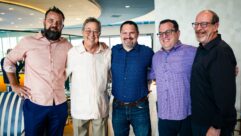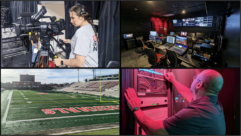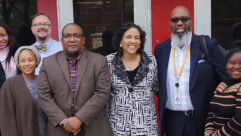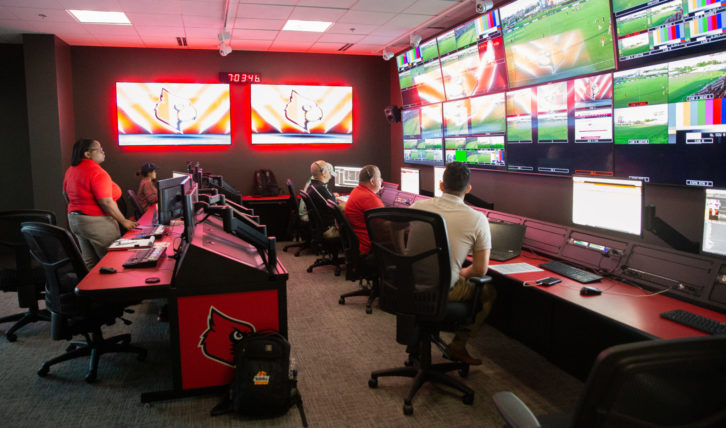
University sports is high-profile and big business. The University of Louisville needed to take a big leap in technology with a new broadcast center for their 13 sports venues. Control room specialists at BeckTV installed the gear, ran the wiring and custom-designed the consoles with Cardinal logos. Senior Engineer Paul Nijak is here to tell us about it.
SVC: Paul, great to have you with us. First tell us a bit about BeckTV
Paul Nijak: BeckTV does premier—almost boutique—broadcast installations. We specialize in broadcast television from ground-up TV stations, to sports production control rooms, like the University of Louisville. We also have a long history in broadcast trucks, network-level big broadcast trucks.
We’re talking about the new Athletics Broadcast Center at the University of Louisville. This is how they do their venue video and how they connect with the ACC and ESPN to televise all the sports events from their many interconnected sports venues. What were they doing before? Weren’t they using some kind of remote truck?
Yeah, that’s exactly right. They were using an old remote trailer. I believe it was limited to four cameras and it was kind of an all-in-one little production system. That trailer allowed them to do big screen support for their venues as well as what they call linear broadcasts for ESPN, which is their internet broadcast or passthrough broadcast as well; most of the time that’s just one camera and one announcer. You just hear someone doing a voiceover of the game for internet streams.
So, what’s changed?
The new facility that we built allows them to do full broadcast productions on ESPN-ACC network—everything you would expect if you’re walking into a full-sized remote truck. There are positions for everyone to sit down—the director, producer, assistant producer, replay positions, a couple of graphics positions as well as an AD position in graphics. It’s not only the communication hub for all those people, but also the equipment to support a full broadcast.
With a sports format it’s primarily all live production.
That’s correct. These rooms are meant for live production. We’ve built them multiple control rooms so, for instance, their control room 1 and control room 2 are identical for broadcast on ESPNACC network. Their control rooms 3 and 4 are meant to support a big screen venue production simultaneously with the on-air production. But it’s all specifically built for live production.
That’s a great question. Each of the 13 sports venues connects via fiber and fortunately on this project we weren’t really that limited in fiber. It was all green space fiber pulled, so we really could tell them how many fibers we needed. So, on the small venues where they weren’t doing many cameras, there were 24 fibers pulled. But on a larger venue, say like their basketball and their football arena, there were 48 fibers pulled to each of those locations. So it’s all direct-run dark fiber between each of the venues.
And that really future-proofs it as much as you possibly can.
It really does. Let’s say that you decide to go 4K, you’re just switching out the end pieces at that point. You’re not having to pull up concrete and asphalt to change anything out.
One of the basics for coordinating live production is having solid, reliable communications. What kind of intercom system did you design into this?
In this project we chose RTS. It’s a known quantity in the broadcast sports industry. We put in not only hardwired RTS—their newer series, the 5032 panels—in all the positions, but we also chose RTS’ ROAMEO wireless for use in their studio as well as in their venues.
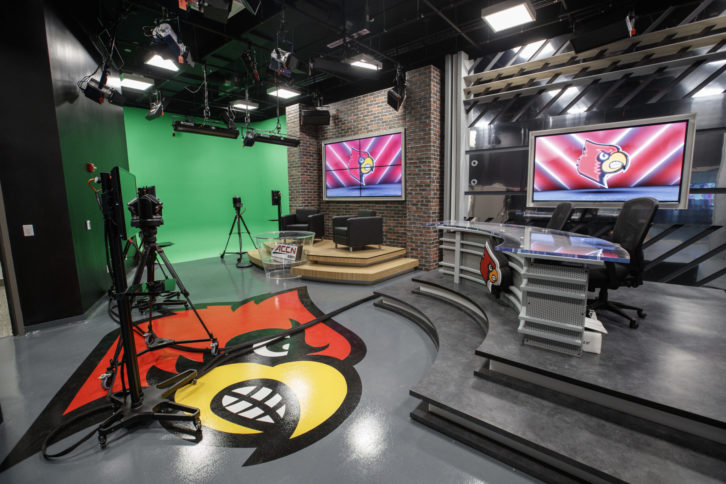 So they can change their communication setup right down to talking directly to the A2s out on the field and all the other individual production people.
So they can change their communication setup right down to talking directly to the A2s out on the field and all the other individual production people.
Correct. Yeah. It’s not only just the personnel associated with the broadcast, it’s also handling the communications for the PR folks, because they’re doing the big screen production as well. So they may be sponsoring fan T-shirts, or they may have kiss-cam or whatever going on, so you’re also handling all the PR marketing communication as well across the wireless.
Yeah, those details can be critical so that you don’t end up with a Tower of Babel during a live show.
Exactly.
You went over this a little before. Tell us about the size and features of the new studios.
I believe it’s approximately 7,800 square feet. They took the shell of an old building that had been used for shipping and receiving and they built the new facility inside. I can paint you a mental picture: there is a studio that has two different sets in it and also a green screen production area for doing headshots and things like that. And then there are also four control rooms. Two of them are two-tier linear control rooms, so they have large consoles in them. A fun little fact about Beck is we’re one of the only integrators that actually builds consoles as well. So all the furniture inside the control room is built right here in-house. That allows us to customize it to the user.
So you can deliver custom-designed control room furniture and consoles as well as the electronics.
Yeah. We are a one-stop shop as far as that’s concerned. At University of Louisville, for instance, Jeremy Noe, who is director of the university broadcast center, chose the colors and he wanted the University of Louisville red for a countertop and also for his end pieces. That’s not a color that is necessarily anywhere on the streets, but we were able to work with our suppliers to get that countertop and to build that countertop into his consoles. It turned out really sharp with a deep black finish on the frame and Louisville red on top.
What was involved in taking that shell of a building and putting in a solid electrical system for sound, video and lighting? That must have been some task in itself.
It really was. The University of Louisville used a consultant. Anthony James Partners. Through the bid process we won the bid and worked closely with AJP to come up with a design. Typically, we do three onsite engineering meetings that are days long at a time. We go through our equipment list line item by line item and then talk about every aspect of the system to make sure we’re grasping from the end user what they want their system to do. Most of the time it’s not a technical person communicating to us—it’s the creative people telling us how they want the system to be used. We take that back and design it to fit their needs. That’s probably about a month and a half process. And then we base the electrical system off that, calculating all the loads—the heat loads, the air conditioning gets sized right, the grounding, that kind of stuff—and communicate that back to the general contractors.
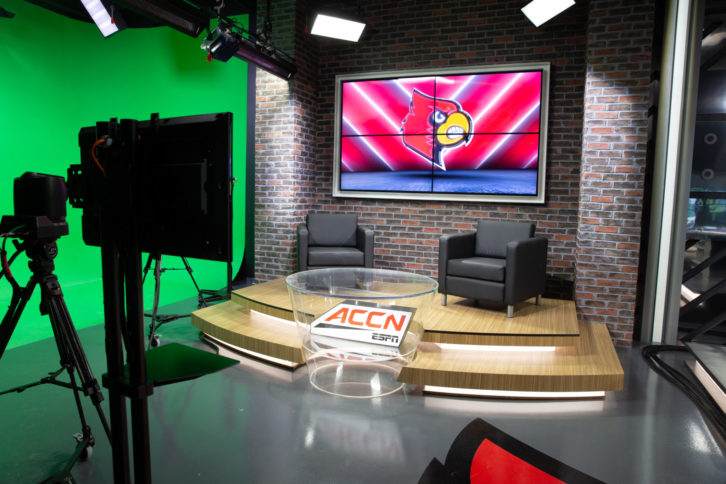 How much cable did you actually have to run?
How much cable did you actually have to run?
38.6 miles of cabling is what we have figured up. And that doesn’t include any of the fiber optics; that’s just the cabling within the broadcast facility there on campus.
After you got it all installed and the fiber connecting everything, how long did it take to ring it all out and test it? Or do you test as you go?
On a system this size you really have to do it as you go. If I had to say a certain time I’d say two weeks continuous of testing every wire and doing that. We start as soon as we put the router in. In this case, it’s an SDI system, baseband, so there are patch panels. We’re testing the router cross points, ins and outs, within 10 days after being on site on typical systems this size. That allows us to first make sure the core of the system is wired correctly. Then from there we move out to the peripherals, all the pieces coming into the system as we start to bring them up online—all of your graphics and then your switchers. At the University of Louisville they had four video switchers, so we had tested each one of those independently as they got wired and came up online. And then last, but not least in this system was intercom and sound. This system almost had more sound than video—because it was two complete broadcast rooms and then front-of-house support for the different venues.
And this was a bit of a compressed schedule. I think they actually wanted to start broadcasting before you even had the place finished.
[Laughs] That’s right. We were given the facility late due to construction being behind schedule. A few short weeks into the build, Jeremy Noe from the university came to me and said that ESPN wants him to do a preseason game—and I forget what the sport was. It was about three, maybe four weeks before our delivery date on the system. And so we came up with a list of what his requirements were to get that facility on air, just to get out of that show. I shook his hand and I said I will do whatever it takes to get the agreed-to facility on the air for you on that date. And sure enough we pulled it off, really without a hitch. We used one of the smaller control rooms that we could get online quickly with its full camera compliment, full intercom and everything ready to go for them.
Day to day, how do they staff that facility? I think they have four full-time people so I would think maybe students and interns are used for the rest of the positions.
They actually do. Jeremy Noe, the director of the facilities there, hires people on a pergame basis and it’s not always students. A lot of times students are busy or can’t commit so he’s got a core group of people that he uses in the community, some of which are students and work their way up. So part of what I did towards the end was game support; once they were on air, I worked with his freelancers to train them on the new equipment to make sure that their positions were operating as they should.
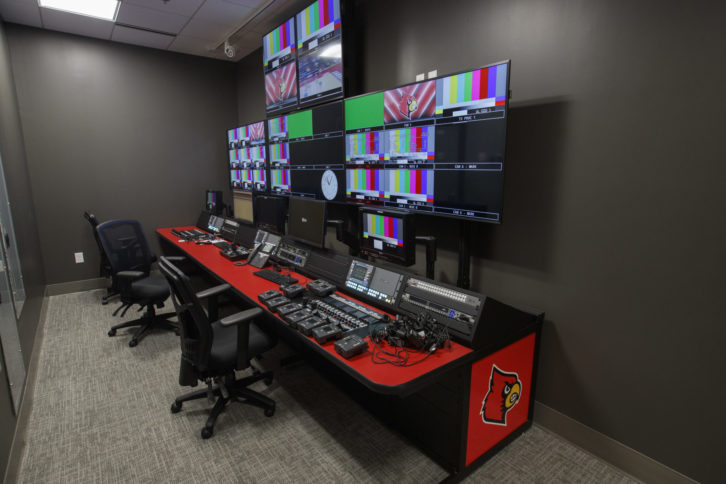 I know they have live game coverage but I would think they have coaching interviews and things like that too.
I know they have live game coverage but I would think they have coaching interviews and things like that too.
They have the two primary broadcast control rooms, which allow them to do two games simultaneously for ESPN on the ACC Network—one linear and one non-linear. And then they also have the two other control rooms that allow them to do a studio show. The rooms also support all the big screens around the campus and the different sports venues; the control rooms can be changed around to control anything individually or independently of each other. They have two different sets in the studio. One is a kind of casual sit-down interview set with a set of monitors behind them that can be fed from the switcher. And then there’s more of a traditional news desk-type thing for an update show if they choose to produce one. They have three cameras in there full time.
That’s a lot of stuff to keep working so who has the regular maintenance on this?
On this job, we have a certain amount of time—I believe it’s one year—that we warranty all of our labor and installation and anything. So if a wire is installed wrong and it got pinched or whatever, we would be responsible for replacing that. However, on the other hand, anything that they have problems with, we’re their first line of defense. Their in-house engineer calls me and we talk about what I believe the problem to be and either I can log in remotely and fix it for them, or if it’s above my knowledge we can start to involve the specific manufacturer to get support there for them.
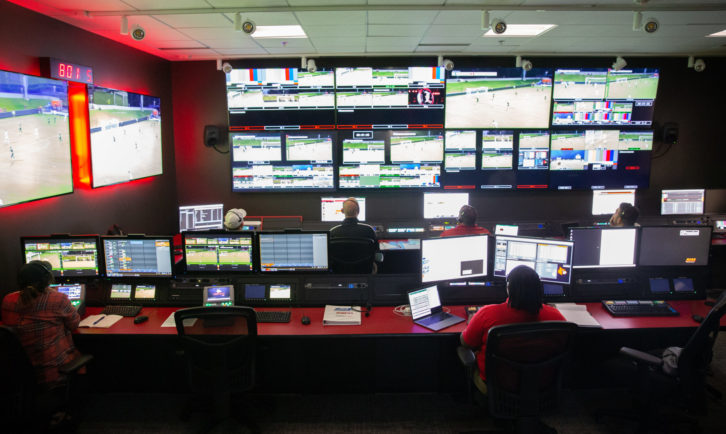 What’s BeckTV working on now?
What’s BeckTV working on now?
I’m personally working on Lucas Oil Stadium in Indianapolis. I’m working on a full broadcast, 53-foot truck for a company, and that’s going to be a complete system design and then buildout. And then as a company we have multiple NBC jobs going on. We’re building four different TV stations currently right now around the country. So very busy, very good.


